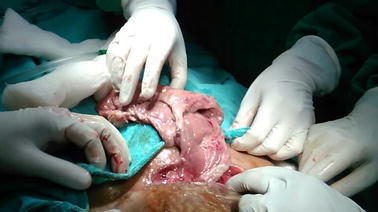Introduction
B-Lynch suturing has become a revolution in the management of atonic PPH when other conservative managements such as uterotonic drugs, uterine packing and devascularization fail. It saves the uterus for future fertility, avoiding obstetric hysterectomy [1]. As in all surgical procedures, it has its own complications. We report a case of obstetric hysterectomy due to total uterine necrosis as a result of B-Lynch suturing.
Case Report
A 27-year-old P1L0 referred from a private hospital came on day 18 following vaginal delivery with chief complaints of pain, abdominal distension and low-grade fever for 6 days with an ultrasound report showing pyometra. History revealed that after a prolonged labor, she had delivered a fresh still born female child of weight 2.25 kg followed by atonic PPH. She was given methergin injection followed by Prostodin injection and misoprost per rectally but bleeding could not be controlled. She had undergone exploratory laparotomy followed by B-Lynch suturing and bilateral uterine artery ligation. She was given 9 units of whole blood and was hospitalized for 13 days and managed with iv antibiotics. Her uterus size remained persistently 26 weeks.
On examination, general condition was fair, pulse was 110/min, temperature was 99.5 degree F, and BP was 110/70 mmHg. On Per abdominal examination uterus was 26 weeks size with tenderness in all quadrants. There was induration around abdominal scar. On local examination, episiotomy wound was unhealthy and foul smelling brownish vaginal discharge was present. Her Hb was 8.6 gms, and WBC count was 14,000/ml. Renal function tests and liver function tests results were normal, and urine routine examination showed plenty of pus cells. Injectable amikacin was started according to culture and sensitivity report. USG showed mild collection in uterine cavity so evacuation of suspected pyometra was done.
After a brief period of 5–6 days, she developed on and off fever and vomiting. Standing X-ray abdomen showed multiple air fluid levels. Patient was managed conservatively for subacute intestinal obstruction, and she recovered in 4–5 days; again she developed fever, tachypnoea and purulent discharge from the abdominal wound site. Culture and sensitivity of wound discharge showed Klebsiella species. Injectable Clindamycin was started as per culture and sensitivity report. For further management, CECT abdomen was done in which large heterogeneous collection with air pockets was seen in the uterine cavity extending up to the skin surface through dehiscence (4–5 cm) in the anterior wall of uterus and abdomen.
Patient was taken up for surgery, and wound debridement was done. It was found that the anterior wall of uterus was adherent to the abdominal wall. On exploration, necrosed endometrial tissue came out of the wound site. The whole of the uterus was necrosed and foul smelling and flabby (Fig. 1). Total abdominal hysterectomy was done followed by anterior abdominal wall repair in layers (Fig. 2). Bilateral tubes and ovaries were found healthy and were preserved. Abdominal drain was given and was subsequently removed after 4 days. Patient was discharged on 15th post-op day with a healthy wound. Histopathology report showed total necrosis of uterus.
Fig. 1.

Necrosed uterus
Fig. 2.

Total abdominal hysterectomy of necrosed uterus
Discussion
Atonic uterus is the most common cause of postpartum hemorrhage, 80% of which respond to uterotonic drugs. Other conservative managements are packing of uterine cavity, selective ligation of uterine vasculature and embolization of uterine artery. Obstetric hysterectomy is the definitive management. Compression suture like B-Lynch suture and its modifications are conservative surgical modalities for preserving future fertility in the management of atonic PPH [2]. B-Lynch and colleagues in 1997 described this surgical technique. The success rate of this suture is 86.4% in avoiding obstetric hysterectomy [1]. It has been popular because of simple technique. Few complications of this technique reported are hematometra, pyometra, Asherman syndrome and partial uterine necrosis [3]. Total uterine necrosis is the worst complication. Very few reported cases are there in the literature [4, 5]. It is one of the causes of non-involution of uterus.
Conclusion
Though B-Lynch suture is used to prevent hysterectomy, if not done appropriately it can be a cause of obstetric hysterectomy. Data on efficacy and safety of these compression suturing techniques are mainly limited to small case series; long-term follow-up information is still lacking especially in those cases where combined procedures like compression suturing and devascularization are done. All the postpartum cases who have undergone compression suturing and devascularization need to be followed up. Prompt imaging technique is invaluable in making the diagnosis.
Dr Abhipsa Mishra
is an Assistant Professor in KIMS Medical College, Bhubaneswar. She did postgraduation from prestigious BYL Nair Hospital, Mumbai. She is a Gold Medalist, Maharashtra University, 2009. She did her training in laparoscopy under Padmashree Dr Sheila Mehra, New Delhi. She has bagged best paper award in annual conferences of MOGS, AICC-RCOG, YUVA FOGSI, BAGE, etc.
Compliance with Ethical Standards
Conflict of interest
None.
Footnotes
Dr Abhipsa Mishra is an Assistant Professor in Department of Obstetrics and Gynaecology, KIMS Medical College. Dr Sudarshan Dash is an Assistant Professor in Department of Obstetrics and Gynaecology, KIMS Medical College. Dr Sudhansu Kumar Rath is an Professor in Department of Obstetrics and Gynaecology, KIMS Medical College.
References
- 1.Chai VY, To WW. Uterine compression sutures for management of severe postpartum haemorrhage: five year audit. Hong Kong Med J. 2014;20:113–120. doi: 10.12809/hkmj134023. [DOI] [PubMed] [Google Scholar]
- 2.Gerli S, Favilli A, Giardona C, et al. Fertility after “only B-Lynch suture”: a case report and literature review. Taiwan J Obstet Gynecol. 2013;52:110–112. doi: 10.1016/j.tjog.2013.01.014. [DOI] [PubMed] [Google Scholar]
- 3.Goojha CA, Case A, Pierson R. Development of Asherman syndrome after conservative surgical management of intractable postpartum hemorrhage. Fertil Steril. 2010;94:1098.e1–1098.e5. doi: 10.1016/j.fertnstert.2010.01.078. [DOI] [PMC free article] [PubMed] [Google Scholar]
- 4.Somalwar SA, Joshi SA, Bhalerao AV, et al. Total uterine necrosis. A complication of B-Lynch suture. J South Asian Fed Obstet Gynaecol. 2012;4:61–63. [Google Scholar]
- 5.Bulusu Ratna, Dharma Vijaya MN, Chandra Mouli A, et al. Total uterine necrosis—a case report with review of literature. J Clin Biomed Sci. 2016;6:33–35. [Google Scholar]


